Second Language Acquisition in North of Jordan, Irbid Region: Report
VerifiedAdded on 2022/08/20
|7
|1541
|16
Report
AI Summary
This report delves into the process of Second Language Acquisition (SLA) in the Irbid region of North Jordan. It explores the background of SLA, highlighting the scientific nature of language learning and the various branches involved, such as pronunciation, grammar, and vocabulary. The report identifies individual differences, including motivation and aptitude, as key factors influencing SLA. It outlines the aims of the research, focusing on the acquisition of linguistic areas and the impact of socio-educational models. The methodology section details the use of a qualitative experimental research method, data-driven approaches, and Form-Focused Instruction (FFI) to enhance grammar and vocabulary learning. Expected outcomes include the impact of glossing methods and grammar instruction on language acquisition. The report also provides a timetable for the research, covering preparation, literature review, data collection, analysis, and final submission. References to relevant academic sources are included to support the findings and analysis.
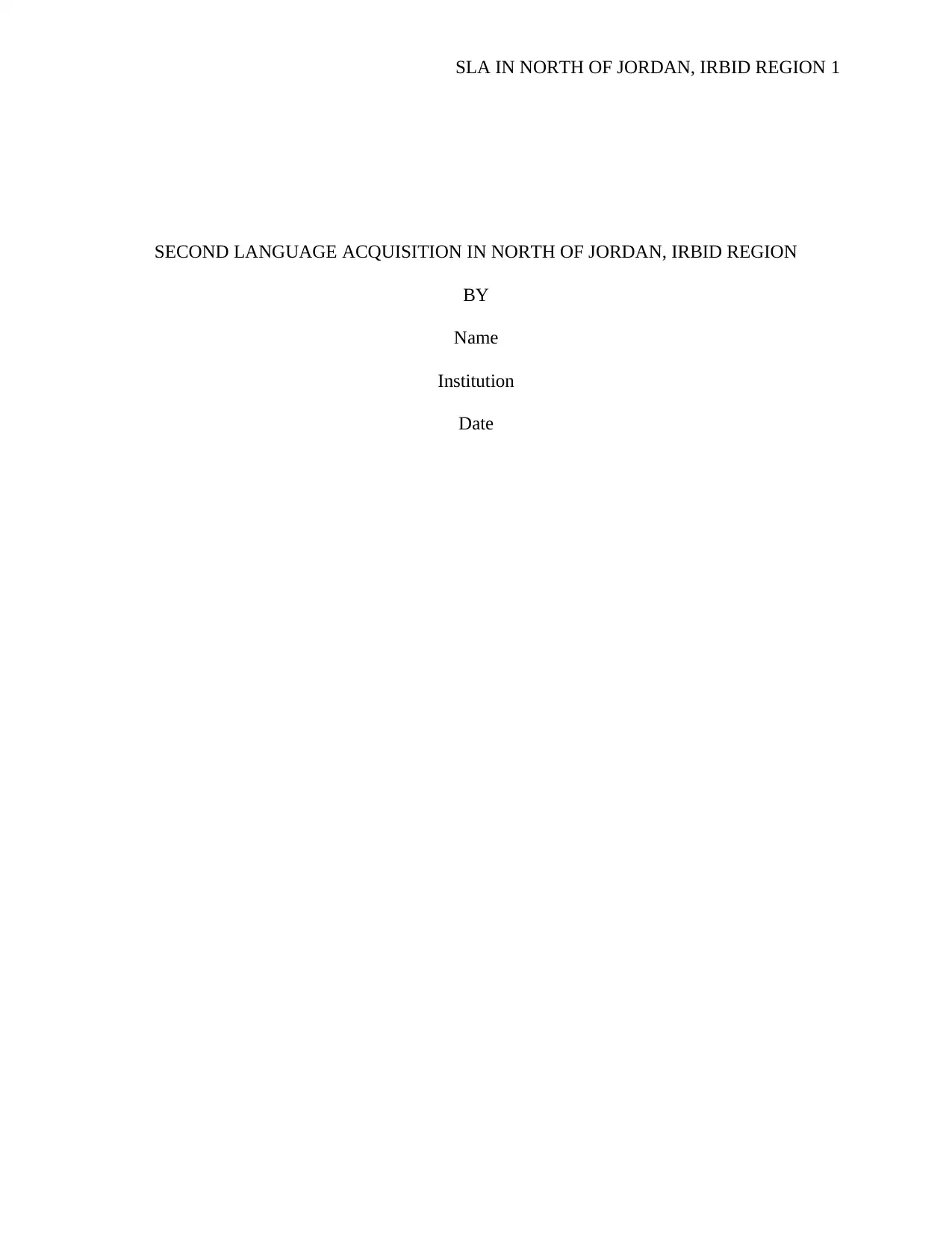
SLA IN NORTH OF JORDAN, IRBID REGION 1
SECOND LANGUAGE ACQUISITION IN NORTH OF JORDAN, IRBID REGION
BY
Name
Institution
Date
SECOND LANGUAGE ACQUISITION IN NORTH OF JORDAN, IRBID REGION
BY
Name
Institution
Date
Paraphrase This Document
Need a fresh take? Get an instant paraphrase of this document with our AI Paraphraser
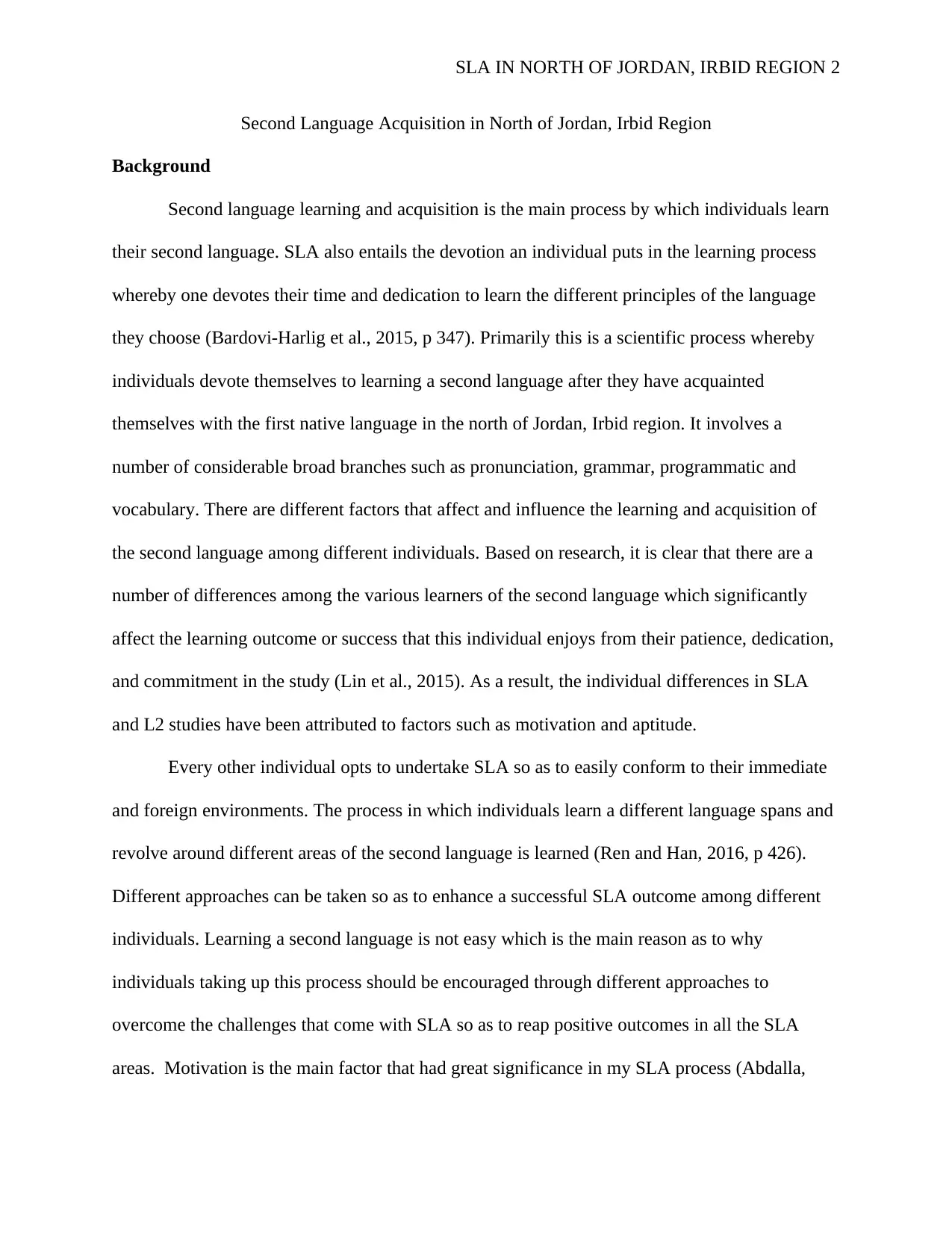
SLA IN NORTH OF JORDAN, IRBID REGION 2
Second Language Acquisition in North of Jordan, Irbid Region
Background
Second language learning and acquisition is the main process by which individuals learn
their second language. SLA also entails the devotion an individual puts in the learning process
whereby one devotes their time and dedication to learn the different principles of the language
they choose (Bardovi-Harlig et al., 2015, p 347). Primarily this is a scientific process whereby
individuals devote themselves to learning a second language after they have acquainted
themselves with the first native language in the north of Jordan, Irbid region. It involves a
number of considerable broad branches such as pronunciation, grammar, programmatic and
vocabulary. There are different factors that affect and influence the learning and acquisition of
the second language among different individuals. Based on research, it is clear that there are a
number of differences among the various learners of the second language which significantly
affect the learning outcome or success that this individual enjoys from their patience, dedication,
and commitment in the study (Lin et al., 2015). As a result, the individual differences in SLA
and L2 studies have been attributed to factors such as motivation and aptitude.
Every other individual opts to undertake SLA so as to easily conform to their immediate
and foreign environments. The process in which individuals learn a different language spans and
revolve around different areas of the second language is learned (Ren and Han, 2016, p 426).
Different approaches can be taken so as to enhance a successful SLA outcome among different
individuals. Learning a second language is not easy which is the main reason as to why
individuals taking up this process should be encouraged through different approaches to
overcome the challenges that come with SLA so as to reap positive outcomes in all the SLA
areas. Motivation is the main factor that had great significance in my SLA process (Abdalla,
Second Language Acquisition in North of Jordan, Irbid Region
Background
Second language learning and acquisition is the main process by which individuals learn
their second language. SLA also entails the devotion an individual puts in the learning process
whereby one devotes their time and dedication to learn the different principles of the language
they choose (Bardovi-Harlig et al., 2015, p 347). Primarily this is a scientific process whereby
individuals devote themselves to learning a second language after they have acquainted
themselves with the first native language in the north of Jordan, Irbid region. It involves a
number of considerable broad branches such as pronunciation, grammar, programmatic and
vocabulary. There are different factors that affect and influence the learning and acquisition of
the second language among different individuals. Based on research, it is clear that there are a
number of differences among the various learners of the second language which significantly
affect the learning outcome or success that this individual enjoys from their patience, dedication,
and commitment in the study (Lin et al., 2015). As a result, the individual differences in SLA
and L2 studies have been attributed to factors such as motivation and aptitude.
Every other individual opts to undertake SLA so as to easily conform to their immediate
and foreign environments. The process in which individuals learn a different language spans and
revolve around different areas of the second language is learned (Ren and Han, 2016, p 426).
Different approaches can be taken so as to enhance a successful SLA outcome among different
individuals. Learning a second language is not easy which is the main reason as to why
individuals taking up this process should be encouraged through different approaches to
overcome the challenges that come with SLA so as to reap positive outcomes in all the SLA
areas. Motivation is the main factor that had great significance in my SLA process (Abdalla,
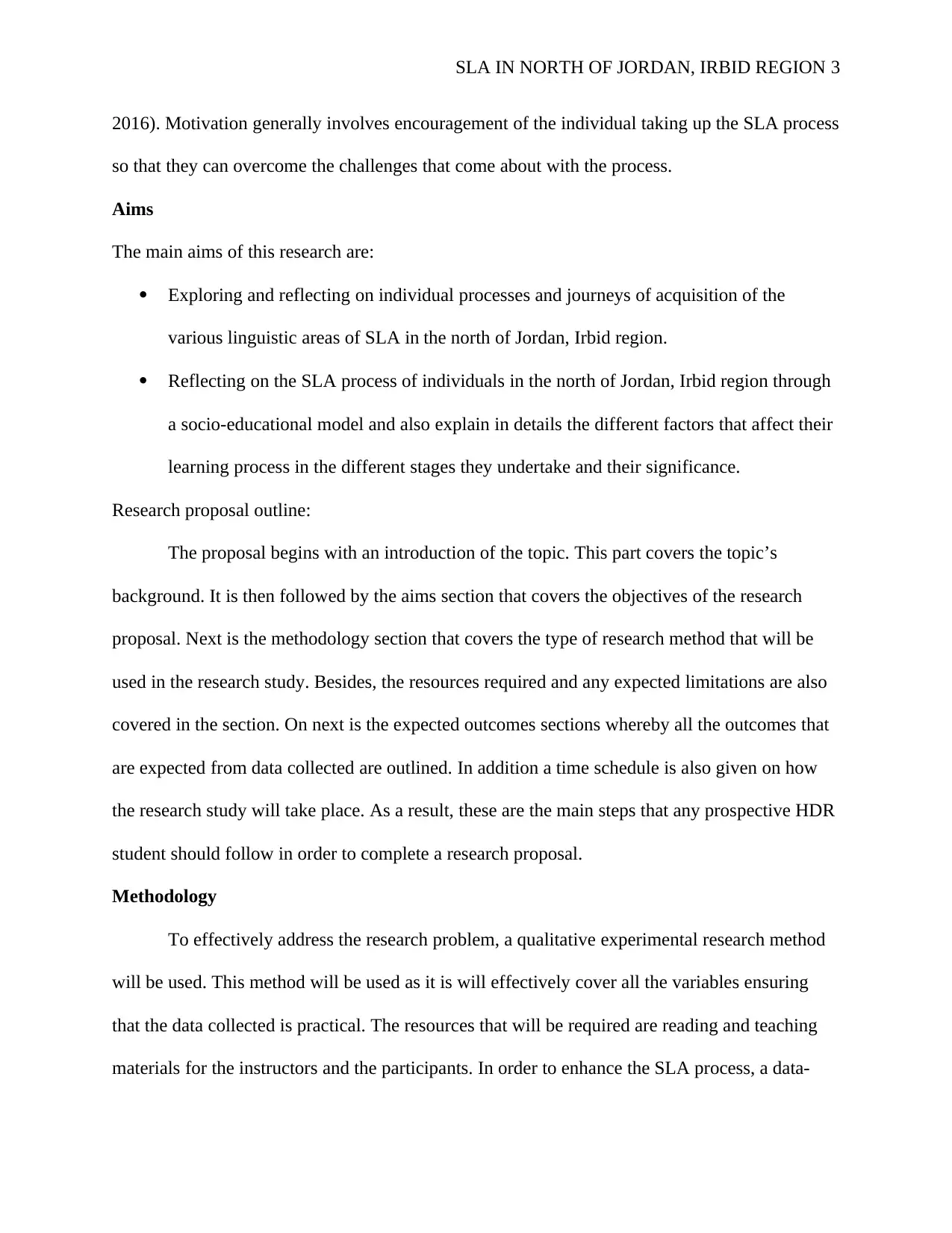
SLA IN NORTH OF JORDAN, IRBID REGION 3
2016). Motivation generally involves encouragement of the individual taking up the SLA process
so that they can overcome the challenges that come about with the process.
Aims
The main aims of this research are:
Exploring and reflecting on individual processes and journeys of acquisition of the
various linguistic areas of SLA in the north of Jordan, Irbid region.
Reflecting on the SLA process of individuals in the north of Jordan, Irbid region through
a socio-educational model and also explain in details the different factors that affect their
learning process in the different stages they undertake and their significance.
Research proposal outline:
The proposal begins with an introduction of the topic. This part covers the topic’s
background. It is then followed by the aims section that covers the objectives of the research
proposal. Next is the methodology section that covers the type of research method that will be
used in the research study. Besides, the resources required and any expected limitations are also
covered in the section. On next is the expected outcomes sections whereby all the outcomes that
are expected from data collected are outlined. In addition a time schedule is also given on how
the research study will take place. As a result, these are the main steps that any prospective HDR
student should follow in order to complete a research proposal.
Methodology
To effectively address the research problem, a qualitative experimental research method
will be used. This method will be used as it is will effectively cover all the variables ensuring
that the data collected is practical. The resources that will be required are reading and teaching
materials for the instructors and the participants. In order to enhance the SLA process, a data-
2016). Motivation generally involves encouragement of the individual taking up the SLA process
so that they can overcome the challenges that come about with the process.
Aims
The main aims of this research are:
Exploring and reflecting on individual processes and journeys of acquisition of the
various linguistic areas of SLA in the north of Jordan, Irbid region.
Reflecting on the SLA process of individuals in the north of Jordan, Irbid region through
a socio-educational model and also explain in details the different factors that affect their
learning process in the different stages they undertake and their significance.
Research proposal outline:
The proposal begins with an introduction of the topic. This part covers the topic’s
background. It is then followed by the aims section that covers the objectives of the research
proposal. Next is the methodology section that covers the type of research method that will be
used in the research study. Besides, the resources required and any expected limitations are also
covered in the section. On next is the expected outcomes sections whereby all the outcomes that
are expected from data collected are outlined. In addition a time schedule is also given on how
the research study will take place. As a result, these are the main steps that any prospective HDR
student should follow in order to complete a research proposal.
Methodology
To effectively address the research problem, a qualitative experimental research method
will be used. This method will be used as it is will effectively cover all the variables ensuring
that the data collected is practical. The resources that will be required are reading and teaching
materials for the instructors and the participants. In order to enhance the SLA process, a data-
⊘ This is a preview!⊘
Do you want full access?
Subscribe today to unlock all pages.

Trusted by 1+ million students worldwide
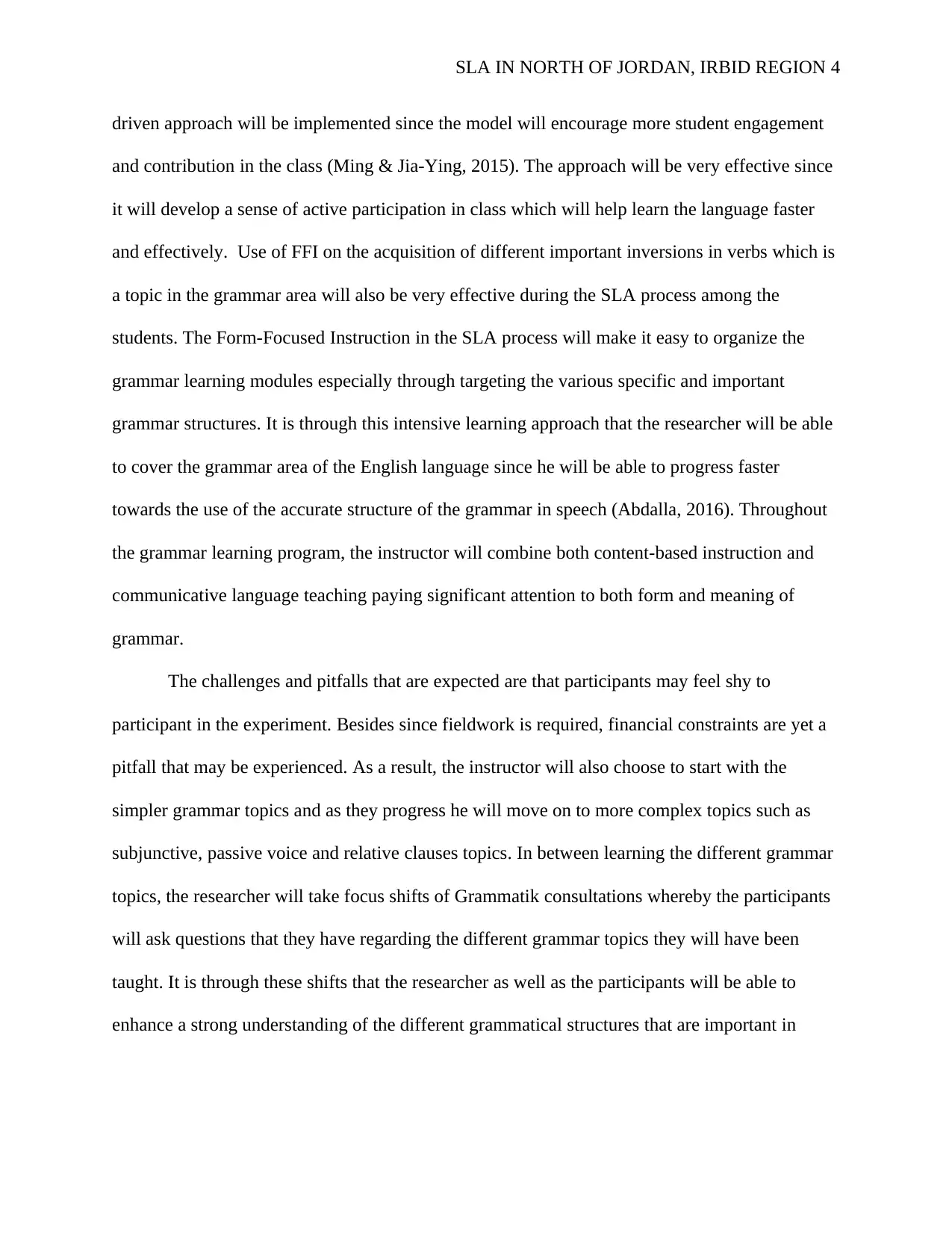
SLA IN NORTH OF JORDAN, IRBID REGION 4
driven approach will be implemented since the model will encourage more student engagement
and contribution in the class (Ming & Jia-Ying, 2015). The approach will be very effective since
it will develop a sense of active participation in class which will help learn the language faster
and effectively. Use of FFI on the acquisition of different important inversions in verbs which is
a topic in the grammar area will also be very effective during the SLA process among the
students. The Form-Focused Instruction in the SLA process will make it easy to organize the
grammar learning modules especially through targeting the various specific and important
grammar structures. It is through this intensive learning approach that the researcher will be able
to cover the grammar area of the English language since he will be able to progress faster
towards the use of the accurate structure of the grammar in speech (Abdalla, 2016). Throughout
the grammar learning program, the instructor will combine both content-based instruction and
communicative language teaching paying significant attention to both form and meaning of
grammar.
The challenges and pitfalls that are expected are that participants may feel shy to
participant in the experiment. Besides since fieldwork is required, financial constraints are yet a
pitfall that may be experienced. As a result, the instructor will also choose to start with the
simpler grammar topics and as they progress he will move on to more complex topics such as
subjunctive, passive voice and relative clauses topics. In between learning the different grammar
topics, the researcher will take focus shifts of Grammatik consultations whereby the participants
will ask questions that they have regarding the different grammar topics they will have been
taught. It is through these shifts that the researcher as well as the participants will be able to
enhance a strong understanding of the different grammatical structures that are important in
driven approach will be implemented since the model will encourage more student engagement
and contribution in the class (Ming & Jia-Ying, 2015). The approach will be very effective since
it will develop a sense of active participation in class which will help learn the language faster
and effectively. Use of FFI on the acquisition of different important inversions in verbs which is
a topic in the grammar area will also be very effective during the SLA process among the
students. The Form-Focused Instruction in the SLA process will make it easy to organize the
grammar learning modules especially through targeting the various specific and important
grammar structures. It is through this intensive learning approach that the researcher will be able
to cover the grammar area of the English language since he will be able to progress faster
towards the use of the accurate structure of the grammar in speech (Abdalla, 2016). Throughout
the grammar learning program, the instructor will combine both content-based instruction and
communicative language teaching paying significant attention to both form and meaning of
grammar.
The challenges and pitfalls that are expected are that participants may feel shy to
participant in the experiment. Besides since fieldwork is required, financial constraints are yet a
pitfall that may be experienced. As a result, the instructor will also choose to start with the
simpler grammar topics and as they progress he will move on to more complex topics such as
subjunctive, passive voice and relative clauses topics. In between learning the different grammar
topics, the researcher will take focus shifts of Grammatik consultations whereby the participants
will ask questions that they have regarding the different grammar topics they will have been
taught. It is through these shifts that the researcher as well as the participants will be able to
enhance a strong understanding of the different grammatical structures that are important in
Paraphrase This Document
Need a fresh take? Get an instant paraphrase of this document with our AI Paraphraser
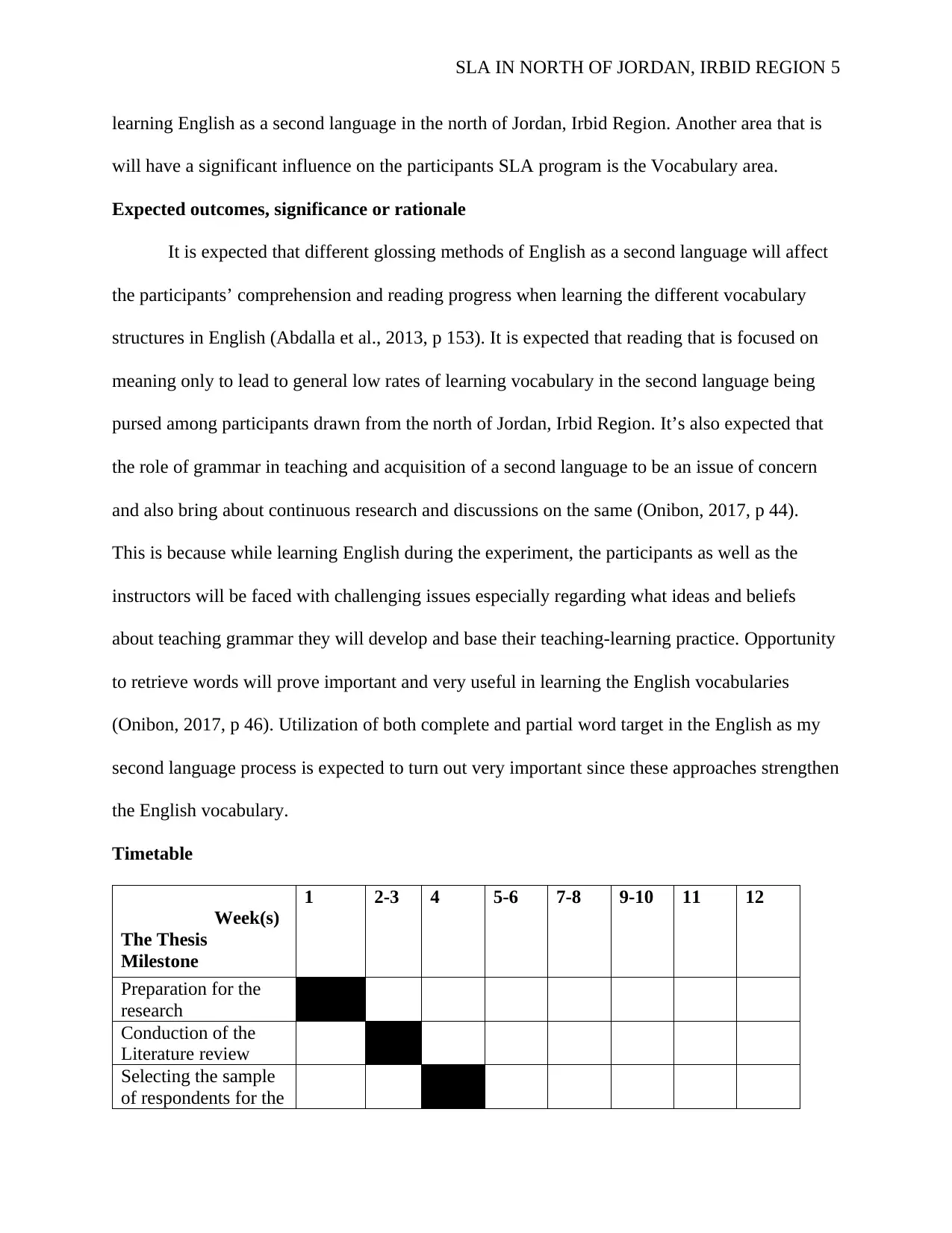
SLA IN NORTH OF JORDAN, IRBID REGION 5
learning English as a second language in the north of Jordan, Irbid Region. Another area that is
will have a significant influence on the participants SLA program is the Vocabulary area.
Expected outcomes, significance or rationale
It is expected that different glossing methods of English as a second language will affect
the participants’ comprehension and reading progress when learning the different vocabulary
structures in English (Abdalla et al., 2013, p 153). It is expected that reading that is focused on
meaning only to lead to general low rates of learning vocabulary in the second language being
pursed among participants drawn from the north of Jordan, Irbid Region. It’s also expected that
the role of grammar in teaching and acquisition of a second language to be an issue of concern
and also bring about continuous research and discussions on the same (Onibon, 2017, p 44).
This is because while learning English during the experiment, the participants as well as the
instructors will be faced with challenging issues especially regarding what ideas and beliefs
about teaching grammar they will develop and base their teaching-learning practice. Opportunity
to retrieve words will prove important and very useful in learning the English vocabularies
(Onibon, 2017, p 46). Utilization of both complete and partial word target in the English as my
second language process is expected to turn out very important since these approaches strengthen
the English vocabulary.
Timetable
Week(s)
The Thesis
Milestone
1 2-3 4 5-6 7-8 9-10 11 12
Preparation for the
research
Conduction of the
Literature review
Selecting the sample
of respondents for the
learning English as a second language in the north of Jordan, Irbid Region. Another area that is
will have a significant influence on the participants SLA program is the Vocabulary area.
Expected outcomes, significance or rationale
It is expected that different glossing methods of English as a second language will affect
the participants’ comprehension and reading progress when learning the different vocabulary
structures in English (Abdalla et al., 2013, p 153). It is expected that reading that is focused on
meaning only to lead to general low rates of learning vocabulary in the second language being
pursed among participants drawn from the north of Jordan, Irbid Region. It’s also expected that
the role of grammar in teaching and acquisition of a second language to be an issue of concern
and also bring about continuous research and discussions on the same (Onibon, 2017, p 44).
This is because while learning English during the experiment, the participants as well as the
instructors will be faced with challenging issues especially regarding what ideas and beliefs
about teaching grammar they will develop and base their teaching-learning practice. Opportunity
to retrieve words will prove important and very useful in learning the English vocabularies
(Onibon, 2017, p 46). Utilization of both complete and partial word target in the English as my
second language process is expected to turn out very important since these approaches strengthen
the English vocabulary.
Timetable
Week(s)
The Thesis
Milestone
1 2-3 4 5-6 7-8 9-10 11 12
Preparation for the
research
Conduction of the
Literature review
Selecting the sample
of respondents for the
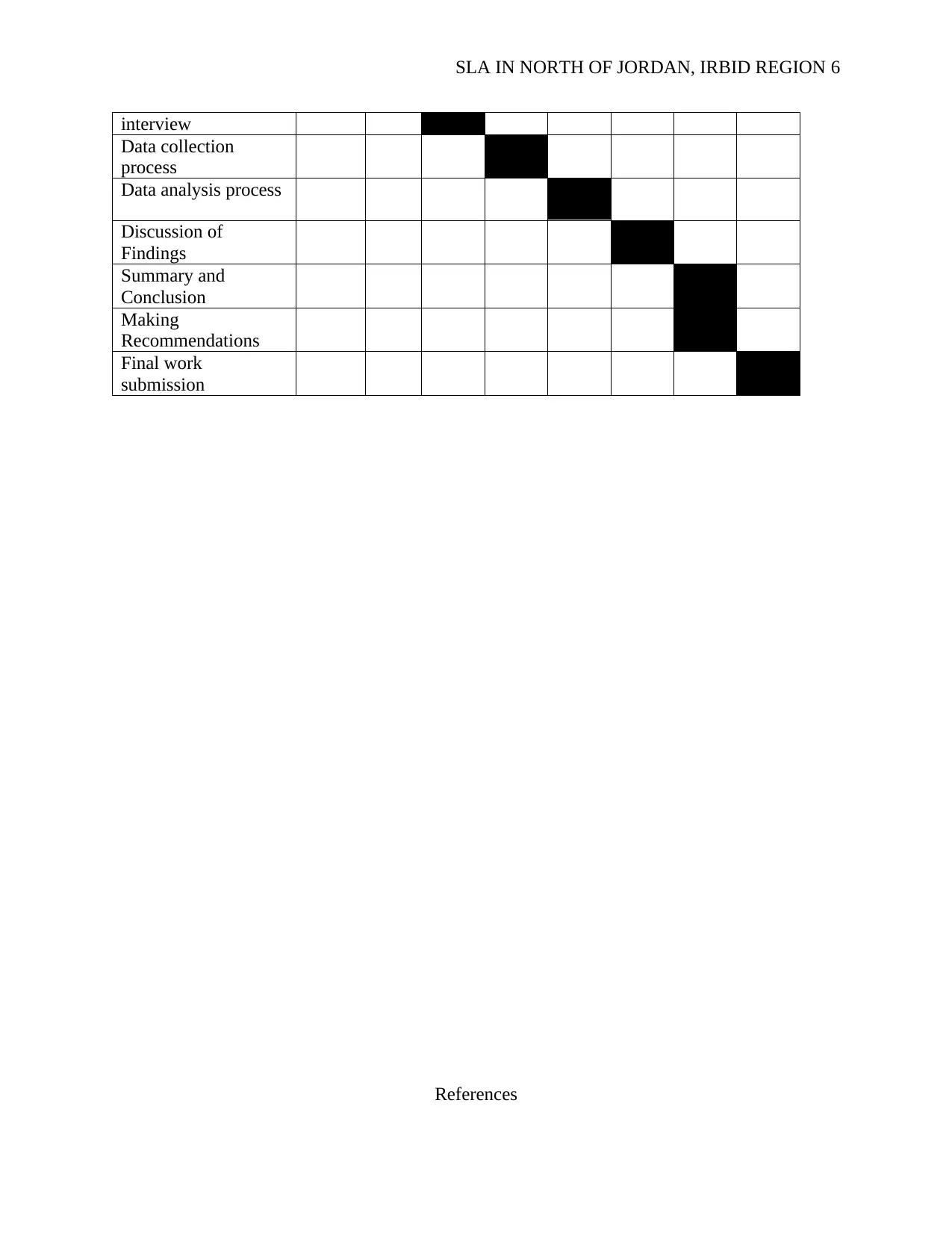
SLA IN NORTH OF JORDAN, IRBID REGION 6
interview
Data collection
process
Data analysis process
Discussion of
Findings
Summary and
Conclusion
Making
Recommendations
Final work
submission
References
interview
Data collection
process
Data analysis process
Discussion of
Findings
Summary and
Conclusion
Making
Recommendations
Final work
submission
References
⊘ This is a preview!⊘
Do you want full access?
Subscribe today to unlock all pages.

Trusted by 1+ million students worldwide
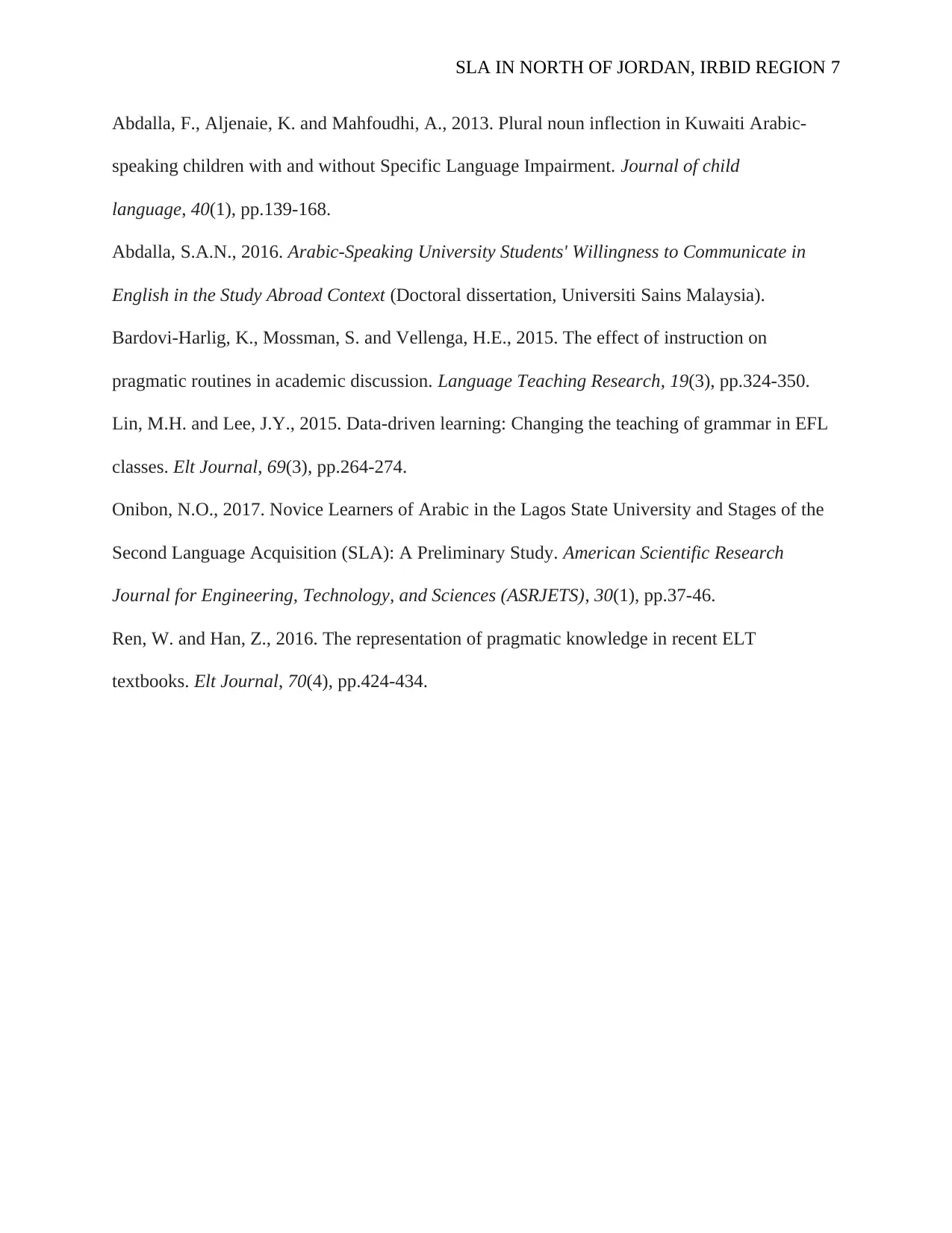
SLA IN NORTH OF JORDAN, IRBID REGION 7
Abdalla, F., Aljenaie, K. and Mahfoudhi, A., 2013. Plural noun inflection in Kuwaiti Arabic-
speaking children with and without Specific Language Impairment. Journal of child
language, 40(1), pp.139-168.
Abdalla, S.A.N., 2016. Arabic-Speaking University Students' Willingness to Communicate in
English in the Study Abroad Context (Doctoral dissertation, Universiti Sains Malaysia).
Bardovi-Harlig, K., Mossman, S. and Vellenga, H.E., 2015. The effect of instruction on
pragmatic routines in academic discussion. Language Teaching Research, 19(3), pp.324-350.
Lin, M.H. and Lee, J.Y., 2015. Data-driven learning: Changing the teaching of grammar in EFL
classes. Elt Journal, 69(3), pp.264-274.
Onibon, N.O., 2017. Novice Learners of Arabic in the Lagos State University and Stages of the
Second Language Acquisition (SLA): A Preliminary Study. American Scientific Research
Journal for Engineering, Technology, and Sciences (ASRJETS), 30(1), pp.37-46.
Ren, W. and Han, Z., 2016. The representation of pragmatic knowledge in recent ELT
textbooks. Elt Journal, 70(4), pp.424-434.
Abdalla, F., Aljenaie, K. and Mahfoudhi, A., 2013. Plural noun inflection in Kuwaiti Arabic-
speaking children with and without Specific Language Impairment. Journal of child
language, 40(1), pp.139-168.
Abdalla, S.A.N., 2016. Arabic-Speaking University Students' Willingness to Communicate in
English in the Study Abroad Context (Doctoral dissertation, Universiti Sains Malaysia).
Bardovi-Harlig, K., Mossman, S. and Vellenga, H.E., 2015. The effect of instruction on
pragmatic routines in academic discussion. Language Teaching Research, 19(3), pp.324-350.
Lin, M.H. and Lee, J.Y., 2015. Data-driven learning: Changing the teaching of grammar in EFL
classes. Elt Journal, 69(3), pp.264-274.
Onibon, N.O., 2017. Novice Learners of Arabic in the Lagos State University and Stages of the
Second Language Acquisition (SLA): A Preliminary Study. American Scientific Research
Journal for Engineering, Technology, and Sciences (ASRJETS), 30(1), pp.37-46.
Ren, W. and Han, Z., 2016. The representation of pragmatic knowledge in recent ELT
textbooks. Elt Journal, 70(4), pp.424-434.
1 out of 7
Related Documents
Your All-in-One AI-Powered Toolkit for Academic Success.
+13062052269
info@desklib.com
Available 24*7 on WhatsApp / Email
![[object Object]](/_next/static/media/star-bottom.7253800d.svg)
Unlock your academic potential
Copyright © 2020–2025 A2Z Services. All Rights Reserved. Developed and managed by ZUCOL.




